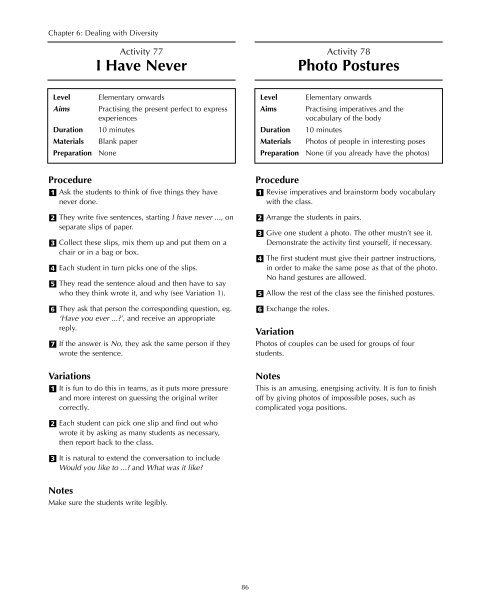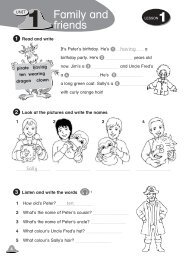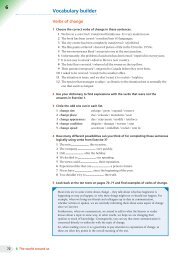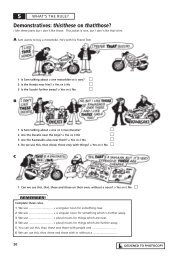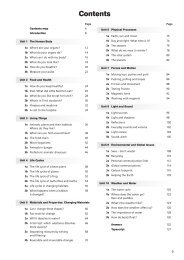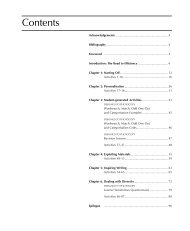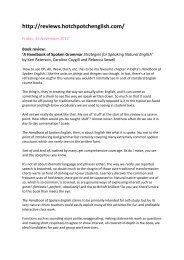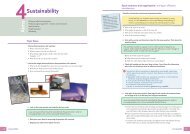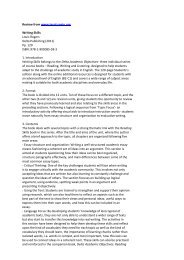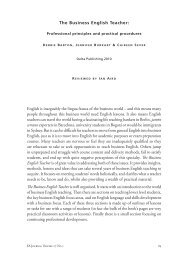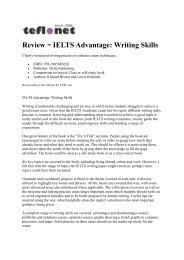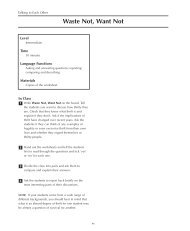MinimaxTeacher_p86-9.. - Delta Publishing
MinimaxTeacher_p86-9.. - Delta Publishing
MinimaxTeacher_p86-9.. - Delta Publishing
You also want an ePaper? Increase the reach of your titles
YUMPU automatically turns print PDFs into web optimized ePapers that Google loves.
Chapter 6: Dealing with DiversityActivity 77I Have NeverActivity 78Photo PosturesLevelElementary onwardsLevelElementary onwardsAimsPractising the present perfect to expressexperiencesAimsPractising imperatives and thevocabulary of the bodyDuration10 minutesDuration10 minutesMaterialsBlank paperMaterialsPhotos of people in interesting posesPreparationNonePreparationNone (if you already have the photos)Procedure1234567Ask the students to think of five things they havenever done.They write five sentences, starting I have never ..., onseparate slips of paper.Collect these slips, mix them up and put them on achair or in a bag or box.Each student in turn picks one of the slips.They read the sentence aloud and then have to saywho they think wrote it, and why (see Variation 1).They ask that person the corresponding question, eg.‘Have you ever ...?’, and receive an appropriatereply.If the answer is No, they ask the same person if theywrote the sentence.Procedure123456Revise imperatives and brainstorm body vocabularywith the class.Arrange the students in pairs.Give one student a photo. The other mustn’t see it.Demonstrate the activity first yourself, if necessary.The first student must give their partner instructions,in order to make the same pose as that of the photo.No hand gestures are allowed.Allow the rest of the class see the finished postures.Exchange the roles.VariationPhotos of couples can be used for groups of fourstudents.Variations1It is fun to do this in teams, as it puts more pressureand more interest on guessing the original writercorrectly.NotesThis is an amusing, energising activity. It is fun to finishoff by giving photos of impossible poses, such ascomplicated yoga positions.23Each student can pick one slip and find out whowrote it by asking as many students as necessary,then report back to the class.It is natural to extend the conversation to includeWould you like to ...? and What was it like?NotesMake sure the students write legibly.86
Chapter 6: Dealing with DiversityDESIGNED TO PHOTOCOPYLevelAimsDurationMaterialsPreparationActivity 79Animal LogicBeginner onwardsPractising the present simple10-15 minutesCopies of the task opposite2 minutesAnimal LogicThere are four animals:Alfie, Butch, Charlie and Dennis,and they each have two hobbies.The lion doesn’t like golf very much.Procedure1234Give out copies of the task opposite to students, inpairs or in groups.Ask them to work together to solve the puzzle.Invite them to justify their answers.Challenge the students to design their own puzzles.Alfie hates golf but reads a newspaper.Charlie isn’t a bull.Charlie collects stamps but the monkeydoesn’t.Alfie isn’t a lion.5Distribute these and repeat the activity as above.The dog drinks whisky but never plays golf.Variations12Different groups can design different activities.If the students design their own puzzles, you cankeep them for another lesson, too.Notes123Lots of puzzles lend themselves to this kind ofactivity.You may need to help some students with themethod. It is a good idea to draw a table, and also tonote down negative information as well as positive.The clues must be read twice, as earlier clues canrelate to later information.Passive knowledge of the present simple is needed toread the clues, but active knowledge is required tospeak about the puzzle and to design another.KeyAlfie: monkey reads smokesButch: dog opera whiskyCharlie: lion stamps rockDennis: bull golf discoButch isn’t a bull.The lion, who collects stamps, doesn’t goto the opera.Charlie is a rock singer, but he neversmokes a pipe.The monkey doesn’t like whisky, stampcollecting or golf.The bull can’t read.The monkey’s name starts with the firstletter of the alphabet.Dennis often plays golf and the bull enjoysdisco dancing.Butch enjoys listening to opera music.Who is the lion, the bull,the dog and the monkey,and what are their hobbies?The MINIMAX Teacher © Jon Taylor published by DELTA PUBLISHING87
Chapter 6: Dealing with DiversityActivity 80Drama DialoguesActivity 81Circle StoryLevelAimsDurationMaterialsPreparationProcedure12345Elementary onwardsPractising dialogues; speaking practice15 minutesNoneNoneSelect a dialogue and write it on the board or OHP(see Note 2).Make sure the students understand it, and drill whereappropriate.Ask them to practise the dialogue in pairs or smallgroups (depending on the number of parts there are).Ask them to practise saying the dialogue in role andin situation, with actions, eg. normal, serious, happy,as old people, on the moon, as cowboys, as horses,as children, in the disco.Allow the students to suggest new situations.Notes1Don’t force anyone to act if they don’t want to. Getto know your class before attempting this kind ofactivity, and warm up to it with other games, ifnecessary.2 I remember a dialogue that worked very well:A: Hi, what are you doing?B: I’m cooking eggs.A: Can I try some?B: Sure.A: Ugh, these are awful. I think I’m going to die!B: Oh no! He’s dying. I’ll get a doctor.Doctor: I’m sorry. He’s dead.LevelAimsDurationMaterialsPreparationProcedure123456Elementary onwardsPractising speaking and listening toothers15 minutesA very short story (see page 89), cutinto about 10 sentences, for eachgroup of students2 minutesArrange the students into a circle (in a large classmake several circles of about ten students).Give each circle the whole story, so that each studentgets one sentence.They mustn’t show their sentences to anyone.Instead, they should read them out to each other.Their task is twofold: to put the story in order and tosit in the correct order.When they have finished, they read out the wholestory.Discuss the meaning or message of the story.VariationThe activity can be done without having to changeplaces and get in order. The students can still put thestory in order.Notes1Some process language might be introduced earlyon. They might need certain expressions, eg. You gobefore me, My part is next, I’m between him and her,etc.234It doesn’t matter if each student is given more thanone sentence. They will just have to occupy twochairs, and hop from one to the other.Putting stories in order involves a lot of languageanalysis and attention to detail.A good story always leaves scope for discussionafterwards.88
Chapter 6: Dealing with DiversityDESIGNED TO PHOTOCOPYA Circle Story StoryThe Difference betweenPenzance and John O’GroatsJohn O’GroatsPenzanceA man sat on a rock by a stream enjoying the peace of the moment.A traveller came by and asked him the way to John O’Groats and what it was like.‘Where are you from?’ asked the man on the rock. ‘Penzance,’ replied the traveller.‘And what’s Penzance like?’ asked the man.‘Oh, it’s a shocking place, depressing, unfriendly and dangerous,’ came the answer.‘Oh dear. Well, you’ll probably find John O’Groats much the same,’ concluded theman on the rock.An hour later another traveller from Penzance came by, asking exactly the samequestions.‘And what’s Penzance like?’ asked the man for the second time that day.‘Oh, it’s a wonderful place, so inspiring, friendly, clean and safe.’‘How nice. Then you’ll probably find John O’Groats much the same,’ concluded theman on the rock by the stream.The MINIMAX Teacher © Jon Taylor published by DELTA PUBLISHING89
Chapter 6: Dealing with DiversityActivity 82Used to JokesLevelAimsDurationMaterialsPreparationIntermediate onwardsPractising used to for past habits andstates; practising giving explanations15 minutesA copy or copies of the jokes below, oran OHP transparency2 minutes (to photocopy the jokes,write them on the board, or preparethe transparency)6 Invite them to explain the jokes to the whole class.7Ask if there are any jokes of this type in their ownlanguage. If there are, ask if they can be translatedand, if so, encourage the students to share them.VariationYou can suggest they investigate jokes in their ownlanguage for homework.Procedure12345Show the jokes to the students. Point out that theyare not in order.Ask them to put them in order and check theiranswers.Whether the students find them funny or not, askhow the jokes work.Demonstrate an explanation of the first joke:‘It implies that he was arrogant in the past, andthis was bad, but that he isn’t now, because nowthere’s nothing wrong with him, but of course hestill is conceited by saying he’s perfect.’Ask the students to practise explaining the jokes toeach other.Notes1234Remember that photocopying makes students lazy!Get them to read the jokes and copy them by hand ifpossible.Help with vocabulary where necessary.Humour often brightens proceedings, but it can beembarrassing if students don’t appreciate orunderstand the joke. Explain that the jokes may notbe funny at all, but that these in particular areexcellent examples of this structure.The vocabulary can be simplified, eg. 1 I used to feelsuperior ... .Key1e) 2g) 3b) 4c) 5f) 6a) 7d)Used to JokesMatch these sentence halves to make jokes:DESIGNED TO PHOTOCOPY1 I used to be conceited a) but now I’m not so sure ...2 I never used to finish anything, b) but now I’m in two minds about it.3 I used to be schizophrenic c) but I’m all right noOOOOOoow ...!4 I used to be a werewolf d) but noww I donnt haavv enny rrobblemmz.5 I never used to be a vegetarian e) but now I’m perfect.6 I used to be indecisive f) but now I always have vegetables with my meat.7 I used to be unable to spell g) but now I ...The MINIMAX Teacher © Jon Taylor published by DELTA PUBLISHING90
Chapter 6: Dealing with DiversityActivity 83Lateral ThinkingLevelAimsDurationMaterialsPreparationIntermediate onwardsPractising Yes/No questions5 minutes per puzzleA copy of the Lateral Thinking Puzzles(see page 92) cut up into individualpuzzles1 minute (to copy the puzzles)Procedure1234Give a demonstration of the activity. Tell the class apuzzle and invite the students to ask you the reasonsbehind it by means of Yes/No questions. You canonly say Yes or No in response to their questions.Keep going until they find the solution.Give out the other puzzles to some students. Itdoesn’t matter if the majority don’t get one, as theywill be the ones working on the solution.Ask each student to come out and read the puzzle tothe class, who ask questions until they solve it.Time the activity. The student with the puzzle thatlasts longest is the winner.VariationYou don’t have to do all the puzzles in the same lesson.You can have one every day.NotesThese puzzles are not new, but often it is the teacherwho sets a problem and answers the questions. This istiring and demands your full attention. If the studentsassume that role, they practise more language, freeingyou to monitor the language and the class dynamics.91
Chapter 6: Dealing with DiversityDESIGNED TO PHOTOCOPYLateral Thinking Puzzles1 There’s a dead man lying in a field. What happened?Answer: He was wearing a parachute which didn’t open. He fell into the field.2 Anthony and Cleopatra lie dead on the living room floor. There’s water and brokenglass on the floor. How did they die?Answer: They were goldfish in a tank, knocked over by a dog.3 A man walked into a bar and ordered a glass of water. Instead, the barman pulled agun on him, but the man said ‘Thanks’ and left the bar satisfied. Why?Answer: He’d had hiccoughs, which are curable by drinking water or by a sudden shock.4 Two pieces of coal and a carrot are lying together in a field. Why?Answer: They were on a snowman’s face. The snowman melted.5 A man is found dead, hanging by the neck from the ceiling of an empty factorywarehouse. There is no chair he could have jumped off. There’s water on the floor.How did he manage to hang himself?Answer: It is a hot climate and the factory produces ice. He stood on a block of iceuntil it melted.6 A woman is woken up by the phone, but the caller hangs up, satisfied. Why?Answer: The caller is next door and couldn’t sleep because of the woman’s snoring.The phone call interrupted the snoring.7 A man passes a window, hears the phone ringing and screams. Why?Answer: He’d decided to commit suicide by jumping out of a skyscraper window,because after a nuclear war he thought he was the last person left alive. The phoneringing disproves that, but it’s too late, as he’s already falling through the air.8 A man makes a return journey by train to see his doctor, but on the way backcommits suicide. Why?Answer: He’d gone for an operation to cure his blindness. On the way home the trainwent through a tunnel, and the man thought his blindness had returned.The MINIMAX Teacher © Jon Taylor published by DELTA PUBLISHING92
Chapter 6: Dealing with DiversityActivity 84Song AntonymsActivity 85Wordbuilding to MusicLevelAimsDurationMaterialsPreparationElementary onwardsPractising vocabulary; listening15-20 minutesA song on cassette; blank paper5 minutesLevelAimsDurationMaterialsPreparationElementary onwardsPractising listening; wordbuilding15 minutesBlank paperIt depends how well you know thesong you choose.Procedure1 Before class, study or recall the lyrics to a song. ProcedureChoose some key words and think of approximateantonyms (opposites) for these words.1Choose a song which is fairly rich in vocabulary, eg.nouns, verbs, adjectives and adverbs.2345678Write them in a vertical list on the board.Arrange the class into teams, either pairs or smallgroups.Each team writes down one antonym for every wordin the list on the board.Tell them that they will hear something on thecassette. They get one point every time their wordsare mentioned, including all repetitions.Count up the points to see who the winners are.Elicit which words appeared in the song, pairingthem with your list of opposites on the board.Elicit as much of the song as you can.Variations123You can vary the antonyms, and the number of them,according to the students’ level.You can vary the number of opposites for each word,eg. light has dark, gloomy, heavy, etc., according tolevel and time.You might ask the students to put the words in theorder that they appear in the song.NotesIt is not necessary to have a copy of the lyrics for thisactivity. The song should be clear and preferably wellknown.I always use Yesterday by The Beatles, and mylist of antonyms includes tomorrow, near, there,gradually, woman, light, come, right, short, hate, work,show.2345678910Ask the students to draw a table of four columns andto label them Nouns, Verbs, Adjectives and Adverbs.Dictate some of the key words in the song, butchange the part of speech, eg. if it says beautiful inthe song, dictate beauty or beautifully.The students have to write the word in the correctcolumn.Group the students, so that they can compare andhelp each other. They then complete all the gaps inthe grid, using dictionaries if they like.Go over the answers, not forgetting pronunciation,and drill where appropriate.Play the song.The students tick any words they hear, in theappropriate column according to the part of speech.Ask the students to try to remember the line in whichtheir words appeared.They listen to the song again and again, until theycan reconstruct the lyrics.VariationYou can vary the number of words in the table, and alsothe number of parts of speech, eg. you might wish toinclude opposites of adjectives and adverbs, usingprefixes.NotesIt is not necessary to have a copy of the lyrics for thisactivity. The song should be clear and preferably wellknown.I always use The Logical Song by Supertramp.93
Chapter 6: Dealing with DiversityLevelAimsDurationMaterialsPreparationProcedure123456Activity 86Ring of WordsElementary onwardsPractising vocabulary, writing andlistening25 minutesBlank paperNoneGive the students eight or ten key words from a songyou know. Write them in random order in a ring onthe board, and ask them to copy them down.Individually, in pairs or in small groups, ask thestudents to make up a short story using all the words.Invite them to tell their stories to the class.Play the song. Ask the students to tick the words asthey hear them, and at the same time put them inorder.In pairs, they try to remember the lines in which theyheard the words.Challenge them to reconstruct the whole song ifappropriate. Play the song for them again asnecessary.VariationThe students can predict what the song is about from thering of words, before writing their own stories.Notes1It is not necessary to have a copy of the lyrics for thisactivity. The song should be clear and preferablywell-known. I always use Norwegian Wood by TheBeatles, and the ring of words includes girl, room,anywhere, chair, wine, morning, wood, laugh, bird,fire.Activity 87Collaborative StoryDictationLevel Elementary onwardsAims Practising the four skillsDuration 20 minutesMaterials Blank paper; the story (see page 95)Preparation NoneProcedure123456Divide the class into four groups.Dictate five different sentences to each group, inrandom order.Ask the students to write each sentence on a separateslip of paper. Make sure each student writes all fivesentences.When they have finished, allow some time forconferring.Re-arrange the class so that every new group has atleast one student from each of the old groups. Youneed as many new groups as there were students inthe smallest old group.The new groups have all 20 sentences. They have toput them in the correct order.VariationFor heterogeneous classes, you can select longersentences for the stronger groups (without making itobvious).Notes12Organise the sentences beforehand and numberthem.The students can ask for repetitions, if necessary.94
Chapter 6: Dealing with DiversityDESIGNED TO PHOTOCOPYPeter and LucyOnce upon a time there were two lovers, called Peter and Lucy,who lived either side of a dangerous river.They saw each other secretly every day.Peter, who had a boat, always visited Lucy, usually in the evenings after work.One day, Lucy was a little surprised that Peter didn’t turn up.After three days, she was worried that something bad had happened to Peter.So she decided to go and find him.First she asked Michael, the boatbuilder, to take her across the river.But Michael wanted to charge her, and she had no money.She asked Stephen, who had a boat, to help her,but he said he would only take her if she slept with him.She went back and told her parents everything, and asked them for some money.Michael took her across, but refused to wait for her.When she eventually found Peter’s house, another woman answered the door.She tried to see Peter, but in vain.Heartbroken, she wandered around for a while, then thought about getting back home.There was no boat, so she walked two miles to a bridge,which was guarded by a soldier called Oscar.He stopped her, saying that his General had forbidden anyone to cross the bridge.In the end, she swam into the dangerous river and died.The MINIMAX Teacher © Jon Taylor published by DELTA PUBLISHING95
EpilogueThis book has attempted to achieve a workablecombination of efficient strategies. Some of these aim toconserve or exploit inputs to make them longer-lastingor more versatile. Others aim to activate the studentsinto producing more output and to promote moreeffective learning. Most of the strategies, however, aimto do both at the same time.Perhaps now is a good time to reacquaint ourselves withthe eleven fictitious, beleaguered teachers we met in theIntroduction. Why they are under so much stress maynow be somewhat clearer:John and Mary might benefit from minimising theirinput, giving the students more responsibility andthinking about using student-generated and personalisedactivities.Jane will remind her students how much more they willlearn by doing the above.Pete could also involve and challenge his adolescentsmore, so that they are not so passive, and this may beenough to avoid negativity.Judith could ask the students to check and redraft workbefore she sees it, so that the marking is reduced, andshe might also benefit from not giving numerical marks,so that they read her comments and learn from heradvice.Mark would find life easier with a simple filing systemof labelled binders and folders, set up at the start of termand kept in order throughout the year. A little effort atthe right time can save hours of stress and turmoil lateron.All of these considerations are based on the tenMINIMAX Principles (pages 10-11), which have servedas the pedagogical foundation of this book.Adam would benefit from the above ideas, and alsofrom making the most of his prepared materials:adapting the level, adopting a flexible approach andencouraging a greater degree of autonomy in hislearners.Jack might be better off preparing less elaboratematerials and even involving the students in collectingthem for him.Roy should keep his materials filed, ready for use.Helen might find the debates will work on their own,allowing the students to express what they really think.Sally could take a less central role and challenge thestudents with tasks and roles of responsibility, givingthem a touch of the limelight, too, while allowingherself the chance to evaluate their performance.96


